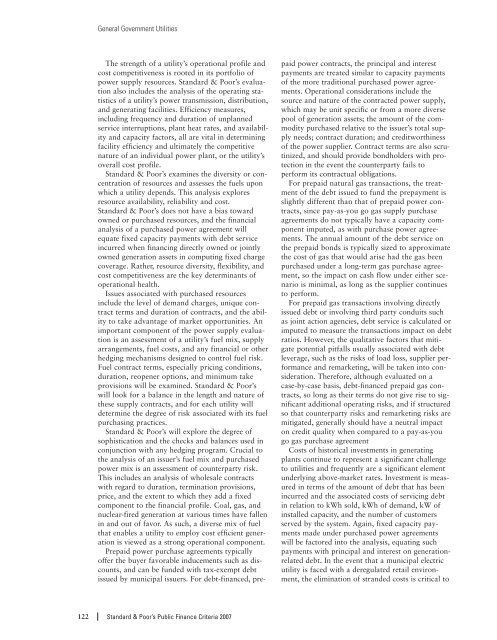S&P - Public Finance Criteria (2007). - The Global Clearinghouse
S&P - Public Finance Criteria (2007). - The Global Clearinghouse
S&P - Public Finance Criteria (2007). - The Global Clearinghouse
Create successful ePaper yourself
Turn your PDF publications into a flip-book with our unique Google optimized e-Paper software.
General Government Utilities<strong>The</strong> strength of a utility’s operational profile andcost competitiveness is rooted in its portfolio ofpower supply resources. Standard & Poor’s evaluationalso includes the analysis of the operating statisticsof a utility’s power transmission, distribution,and generating facilities. Efficiency measures,including frequency and duration of unplannedservice interruptions, plant heat rates, and availabilityand capacity factors, all are vital in determiningfacility efficiency and ultimately the competitivenature of an individual power plant, or the utility’soverall cost profile.Standard & Poor’s examines the diversity or concentrationof resources and assesses the fuels uponwhich a utility depends. This analysis exploresresource availability, reliability and cost.Standard & Poor’s does not have a bias towardowned or purchased resources, and the financialanalysis of a purchased power agreement willequate fixed capacity payments with debt serviceincurred when financing directly owned or jointlyowned generation assets in computing fixed chargecoverage. Rather, resource diversity, flexibility, andcost competitiveness are the key determinants ofoperational health.Issues associated with purchased resourcesinclude the level of demand charges, unique contractterms and duration of contracts, and the abilityto take advantage of market opportunities. Animportant component of the power supply evaluationis an assessment of a utility’s fuel mix, supplyarrangements, fuel costs, and any financial or otherhedging mechanisms designed to control fuel risk.Fuel contract terms, especially pricing conditions,duration, reopener options, and minimum takeprovisions will be examined. Standard & Poor’swill look for a balance in the length and nature ofthese supply contracts, and for each utility willdetermine the degree of risk associated with its fuelpurchasing practices.Standard & Poor’s will explore the degree ofsophistication and the checks and balances used inconjunction with any hedging program. Crucial tothe analysis of an issuer’s fuel mix and purchasedpower mix is an assessment of counterparty risk.This includes an analysis of wholesale contractswith regard to duration, termination provisions,price, and the extent to which they add a fixedcomponent to the financial profile. Coal, gas, andnuclear-fired generation at various times have fallenin and out of favor. As such, a diverse mix of fuelthat enables a utility to employ cost efficient generationis viewed as a strong operational component.Prepaid power purchase agreements typicallyoffer the buyer favorable inducements such as discounts,and can be funded with tax-exempt debtissued by municipal issuers. For debt-financed, prepaidpower contracts, the principal and interestpayments are treated similar to capacity paymentsof the more traditional purchased power agreements.Operational considerations include thesource and nature of the contracted power supply,which may be unit specific or from a more diversepool of generation assets; the amount of the commoditypurchased relative to the issuer’s total supplyneeds; contract duration; and creditworthinessof the power supplier. Contract terms are also scrutinized,and should provide bondholders with protectionin the event the counterparty fails toperform its contractual obligations.For prepaid natural gas transactions, the treatmentof the debt issued to fund the prepayment isslightly different than that of prepaid power contracts,since pay-as-you go gas supply purchaseagreements do not typically have a capacity componentimputed, as with purchase power agreements.<strong>The</strong> annual amount of the debt service onthe prepaid bonds is typically sized to approximatethe cost of gas that would arise had the gas beenpurchased under a long-term gas purchase agreement,so the impact on cash flow under either scenariois minimal, as long as the supplier continuesto perform.For prepaid gas transactions involving directlyissued debt or involving third party conduits suchas joint action agencies, debt service is calculated orimputed to measure the transactions impact on debtratios. However, the qualitative factors that mitigatepotential pitfalls usually associated with debtleverage, such as the risks of load loss, supplier performanceand remarketing, will be taken into consideration.<strong>The</strong>refore, although evaluated on acase-by-case basis, debt-financed prepaid gas contracts,so long as their terms do not give rise to significantadditional operating risks, and if structuredso that counterparty risks and remarketing risks aremitigated, generally should have a neutral impacton credit quality when compared to a pay-as-yougo gas purchase agreementCosts of historical investments in generatingplants continue to represent a significant challengeto utilities and frequently are a significant elementunderlying above-market rates. Investment is measuredin terms of the amount of debt that has beenincurred and the associated costs of servicing debtin relation to kWh sold, kWh of demand, kW ofinstalled capacity, and the number of customersserved by the system. Again, fixed capacity paymentsmade under purchased power agreementswill be factored into the analysis, equating suchpayments with principal and interest on generationrelateddebt. In the event that a municipal electricutility is faced with a deregulated retail environment,the elimination of stranded costs is critical to122 Standard & Poor’s <strong>Public</strong> <strong>Finance</strong> <strong>Criteria</strong> <strong>2007</strong>
















